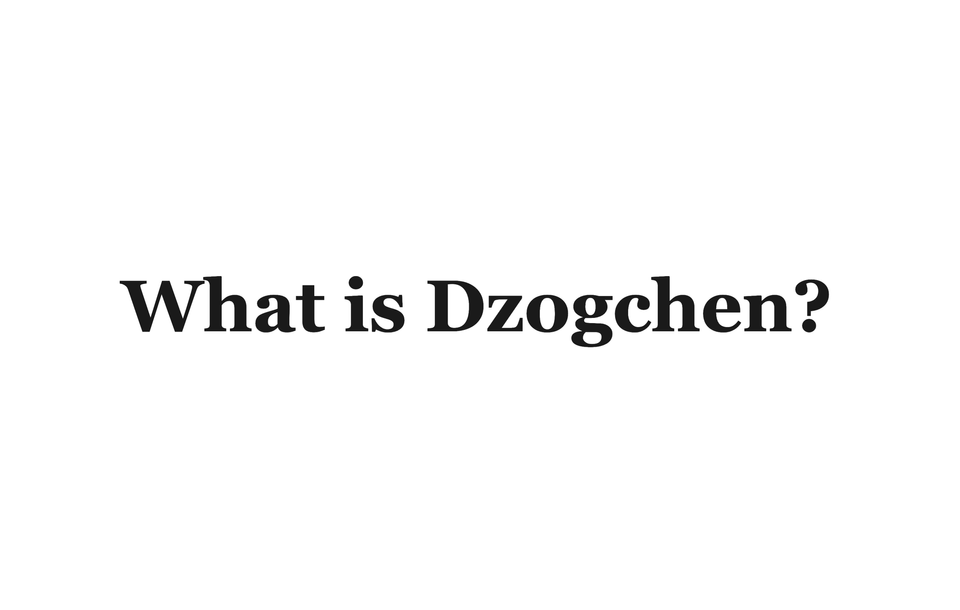What is Dzogchen?

In the past few years, Dzogchen has been trending among spiritual seekers and communities. What was once a secret practice in Tibet is now frequently mentioned on popular podcasts, widely shared in online teachings, and of course celebrated as being the 'highest' and therefore perceived as 'the best' teachings of Tibetan Buddhism.
Yet perhaps the most compelling reason that Dzogchen has found its way into the modern consciousness is its accessibility and the simplicity with which it is often portrayed.
But what is Dzogchen? Why are people talking about it more and how does it relate to our own practice?
In simple terms, Dzogchen is a direct introduction to primordial buddhahood in the immediacy of our own awareness.
But we probably need to unpack that a little bit.
First, let's dig into what Dzogchen means.
The Tibetan dzog means "complete" or "perfect," and chen means "great." So Dzogchen is often translated as Great Perfection, or sometimes Great Completeness.
What is it that is perfect? It is your own nature, just as it is.
The Dzogchen teachings assert that the result we seek–complete and perfect buddhahood or awakening–is fully evident in the immediacy of your own awareness, or called rigpa in Tibetan.
That's a pretty bold perspective. I would say if we're honest with ourselves, none of us feels like that is the case.
To really appreciate the profundity of this view we need to understand it in the context of the Buddha's teachings and the easiest place to start is the four noble truths.
The Four Noble Truths as a basis for understanding Dzogchen
The first teaching the Buddha gave after his awakening was the Setting in Motion the Wheel of Dharma Sutra, in which he taught the four noble truths, laying a foundation for understanding all of his teachings.
The four noble truths are:
- The truth of suffering, which is to be understood
- The truth of the origin, which is to be let go of (attachment, aversion, and ignorance)
- The truth of cessation, which is to be actualized
- The truth of the path, which is to be practiced
The four noble truths can be easily understood by a simple metaphor. We are sick (suffering), that sickness has a cause (origin), a cure is possible (cessation of suffering), and to do so we need to take this medicine (practice the path).
The foundational teachings of the Buddha present a causal approach to awakening. Awakening is possible, but not accessible to us right now. Buddhahood, the result we are seeking, lies somewhere in the future and it depends on causes and conditions.
This causal or gradual approach to awakening forms the basis of the Buddhist path, but it is not the only path to be traveled.
Intro: Buddhanature
With the third turning of the wheel of Dharma and the teachings on the tathatagarbha (buddhanature) came a change in the view and the subsequent path.
The teachings on buddhanature assert that the result of awakening is present in us as the nature of the mind itself. However, this view takes on different levels of understanding and practice.
In the Mahayana sutras, that buddhanature is seen as a potential or a seed that needs to be ripened. Much like the foundational teachings of the Buddha, this approach is a causal approach that relies on the accumulation of merit and wisdom to 'develop' that buddhanature into full awakening.
The Vajrayana tradition take a different approach. As a resultant vehicle, the Buddhist tantras maintain the view that buddhanature is fully present but that it is obscured by defilements. Like a statue covered with mud, the view is that we need to purify the impurities of ordinary mind in order to actualize awakened mind (which is equivalent to 3rd noble truth).
While the view of the Buddhist tantras is close to the Dzogchen view, there is still the notion that something needs to be purified, the mind needs to be improved, processed, or made better.
The non-dual Vajrayana traditions of Mahamudra and Dzogchen take the radical approach that our buddhanature if fully evident in the immediacy of our own awareness.
Realizing this directly is the essence of Dzogchen.
Realization here doesn't simply mean understanding which is conceptual. Realization means to actualize, or bring this truth into direct experience.
So the significance of Dzogchen is that the result of awakening is not distant or conditional– it is imminent. It is fully evident and accessible to us, here and now, if we know how to recognize it and resolve all experience in that single sphere of awareness itself.
Bringing it all home
The key point of Dzogchen is that the result of the path is not somewhere else. There is nothing to purify, nothing to fix, and nothing to improve. The primordial state, our own intrinsic awareness, is perfect just as it is.
This is the natural Great Perfection, rangzhin Dzogpa Chenpo–our true nature, realized in the immediacy of authentic presence.
Dzogchen is not a teaching of transcendence. Awakening is not in some distant pure land or far-off future state. It is imminent, accessible, and fully evident here and now if we know how to recognize it.
And this immediacy sets the stage for one of the biggest misconceptions of Dzogchen.
The pointing-out instructions
All this sounds inspiring and maybe we can appreciate why the Dzogchen teachings are said to be the highest teachings of Tibetan Buddhism. Garab Dorje's Three Statements that Hit the Vital Point provide a clear framework for understanding the practice of Dzogchen:
- Introduction to one's own true nature.
- Be decisive about this unique state.
- Continue with confidence in liberation.
The first step, the introduction, tends to generate the most excitement.
Many people (let's face it, most) think they are going to be getting something that they don't already have. They think that the teacher or guru is going to transmit some thing to them, like a gift that they now possess.
But what is being pointed out or introduced is not something that is external or newly acquired. It is what has been always present: our buddhanature. While naturally present, it remains unrecognized, and because of that we don't experience the freedom and opportunity that it's presence offers.
What is being pointed out is the view: our natural condition is stainless, non-dual, ever-present awareness. To recognize that view, we need to be in a position to be receptive enough to the instruction when it is being pointed out.
To do that, we need to train. We need to be prepared. We need to be experts in working with mind and familiar with the nature of mind. To truly benefit from the Dzogchen teachings, we need to be practitioners who are committed to a life of practice, integrating everything with the path.
Without that commitment, we are just falling into the trap of hope and gain– dualistic notions rooted in the belief that we are lacking something, inadequate, not enough.
Which I guess brings us full circle for why Dzogchen has entered the collective consciousness. Our culture is built on feelings of inadequacy. Many of us feel like we are not good enough. We don't recognize a sense of innate dignity or self-worth.
Dzogchen points out our innate dignity. Our basic nature as being always good– the primordial Buddha Samantabhadra, meaning "all good," perfectly captures this truth.
And people want that. We deserve that.
Recognizing the innate dignity of the ground of our being–the natural Great Perfection–is our birthright. And there is a path to realize it in the immediacy of our own awareness.
It's time to get to work.




